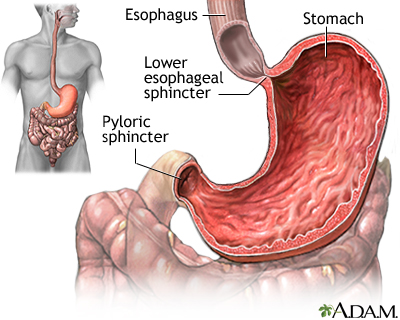Gastroparesis
Gastroparesis diabeticorum; Delayed gastric emptying; Diabetes - gastroparesis; Diabetic neuropathy - gastroparesis
Gastroparesis is a condition that reduces the ability of the stomach to empty its solid contents. It does not involve a blockage (obstruction) of the outlet of the stomach.
Images


I Would Like to Learn About:
Causes
The exact cause of gastroparesis is unknown. It may be caused by a disruption of nerve signals to the stomach. The condition is a common complication of diabetes. It can also follow some surgeries.
Risk factors for gastroparesis include:
- Diabetes, especially long-term diabetes or if the blood sugar is very high
- Gastrectomy (surgery to remove part of the stomach)
- Systemic sclerosis and other autoimmune diseases
- Post-viral illness
- Parkinson disease
- Use of medicine such as those that block certain nerve signals (anticholinergic medicine) or muscle contraction (narcotic pain relievers)
Symptoms
Symptoms may include:
- Abdominal distention
- Abdominal pain
- Hypoglycemia (in people with diabetes)
- Nausea
- Premature abdominal fullness after meals or feeling full after eating only a small amount of food
- Weight loss without trying
- Vomiting
Exams and Tests
Tests you may need include:
- Esophagogastroduodenoscopy (EGD).
- Gastric emptying study (usually using isotope-labeled food). Other tests that are used include a wireless motility capsule or a breath test.
- Upper GI series.
Treatment
People with diabetes should always control their blood sugar level. Better control of blood sugar level may improve symptoms of gastroparesis. Eating small and more frequent meals and soft/pureed foods (called a small-particle diet) may also help relieve some symptoms.
Medicines that may help include:
- Erythromycin (short-term only)
- Metoclopramide, a medicine that helps empty the stomach, or domperidone (available with special approval in the US)
- Serotonin (5-HT4) agonist medicines, which act on serotonin receptors
- Anti-nausea treatments to help control nausea and vomiting
Other treatments may include:
- Electrical stimulation of the stomach
- Endoscopic myotomy (cutting muscles at the pylorus, the outlet of the stomach), called G-POEM (gastric per-oral endoscopic myotomy)
- Surgical procedure that creates an opening between the stomach and small intestine to allow food to move through the digestive tract more easily (gastroenterostomy)
If weight loss and malnutrition have occurred, a feeding tube may be inserted into the small intestine to give food until symptoms are better.
Outlook (Prognosis)
Many treatments, especially medicines, seem to provide only temporary benefit or have side effects when used for a long time. Gastroparesis is a chronic condition. Management of flare-ups may be helped by the use of diet and medicines. Endoscopic or surgical myotomy often provides a long-term improvement.
Possible Complications
Ongoing nausea and vomiting may cause:
- Dehydration
- Electrolyte imbalances
- Malnutrition
People with diabetes may have serious complications from poor blood sugar control.
When to Contact a Medical Professional
Changes in your diet may help control symptoms. Contact your health care provider if symptoms continue or if you have new symptoms.
Related Information
DiabetesScleroderma
Gastrectomy
Comprehensive metabolic panel
Dehydration
References
Carmilleri M. Disorders of gastrointestinal motility. In: Goldman L, Cooney KA, eds. Goldman-Cecil Medicine. 27th ed. Philadelphia, PA: Elsevier; 2024:chap 122.
Camilleri M, Kuo B, Nguyen L. ACG Clinical Guideline: Gastroparesis. Am J Gastroenterol. 2022;117(8):1197-1220. PMID: 35926490 pubmed.ncbi.nlm.nih.gov/35926490/.
Koch KL. Gastric neuromuscular function and neuromuscular disorders. In: Feldman M, Friedman LS, Brandt LJ, eds. Sleisenger and Fordtran's Gastrointestinal and Liver Disease. 11th ed. Philadelphia, PA: Elsevier; 2021:chap 50.
BACK TO TOPReview Date: 10/30/2024
Reviewed By: Jenifer K. Lehrer, MD, Gastroenterologist, Philadelphia, PA. Review provided by VeriMed Healthcare Network. Also reviewed by David C. Dugdale, MD, Medical Director, Brenda Conaway, Editorial Director, and the A.D.A.M. Editorial team.

Health Content Provider
06/01/2025
|
A.D.A.M., Inc. is accredited by URAC, for Health Content Provider (www.urac.org). URAC's accreditation program is an independent audit to verify that A.D.A.M. follows rigorous standards of quality and accountability. A.D.A.M. is among the first to achieve this important distinction for online health information and services. Learn more about A.D.A.M.'s editorial policy, editorial process and privacy policy. A.D.A.M. is also a founding member of Hi-Ethics. This site complied with the HONcode standard for trustworthy health information from 1995 to 2022, after which HON (Health On the Net, a not-for-profit organization that promoted transparent and reliable health information online) was discontinued. |
The information provided herein should not be used during any medical emergency or for the diagnosis or treatment of any medical condition. A licensed medical professional should be consulted for diagnosis and treatment of any and all medical conditions. Links to other sites are provided for information only -- they do not constitute endorsements of those other sites. © 1997- 2025 A.D.A.M., a business unit of Ebix, Inc. Any duplication or distribution of the information contained herein is strictly prohibited.
